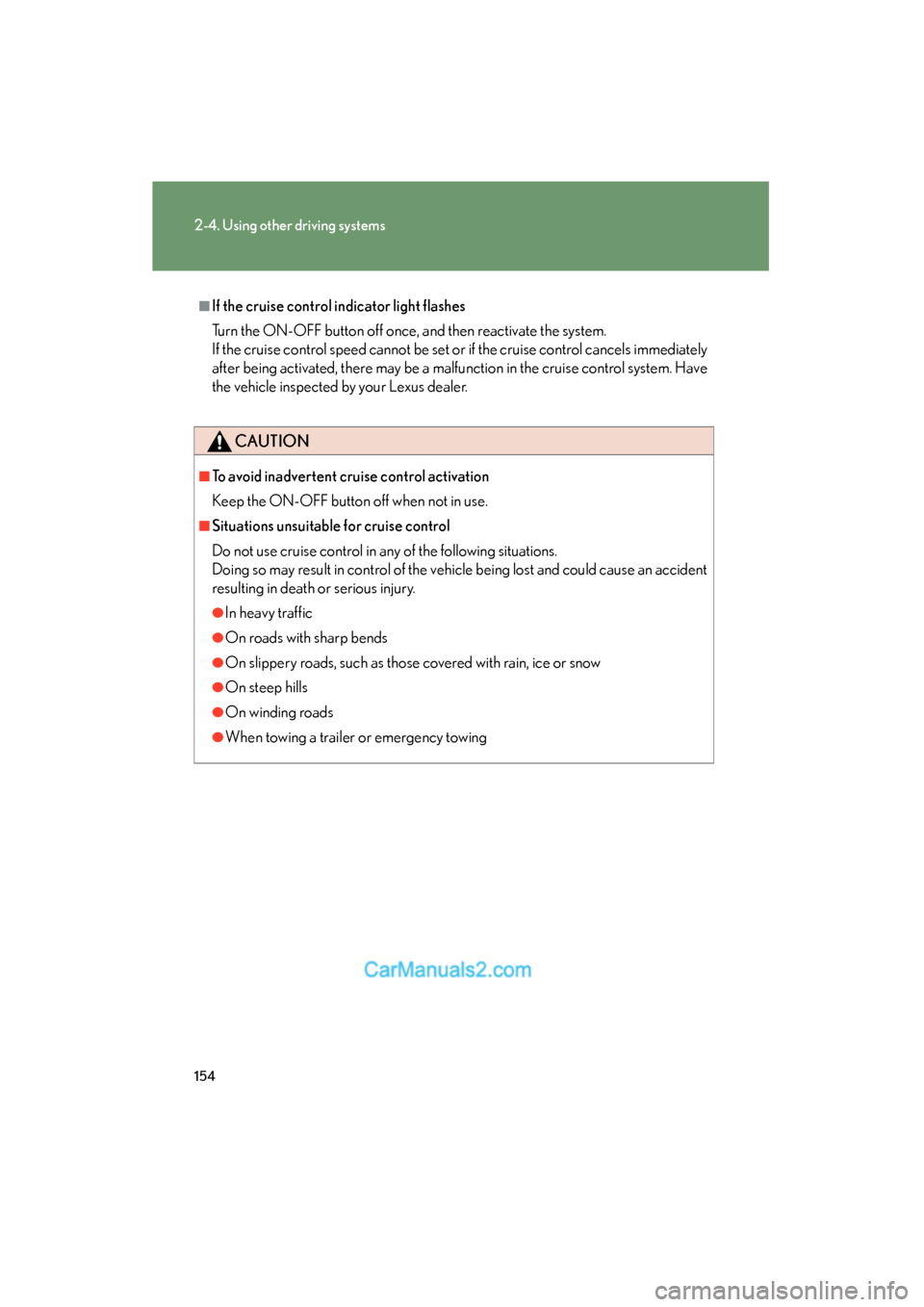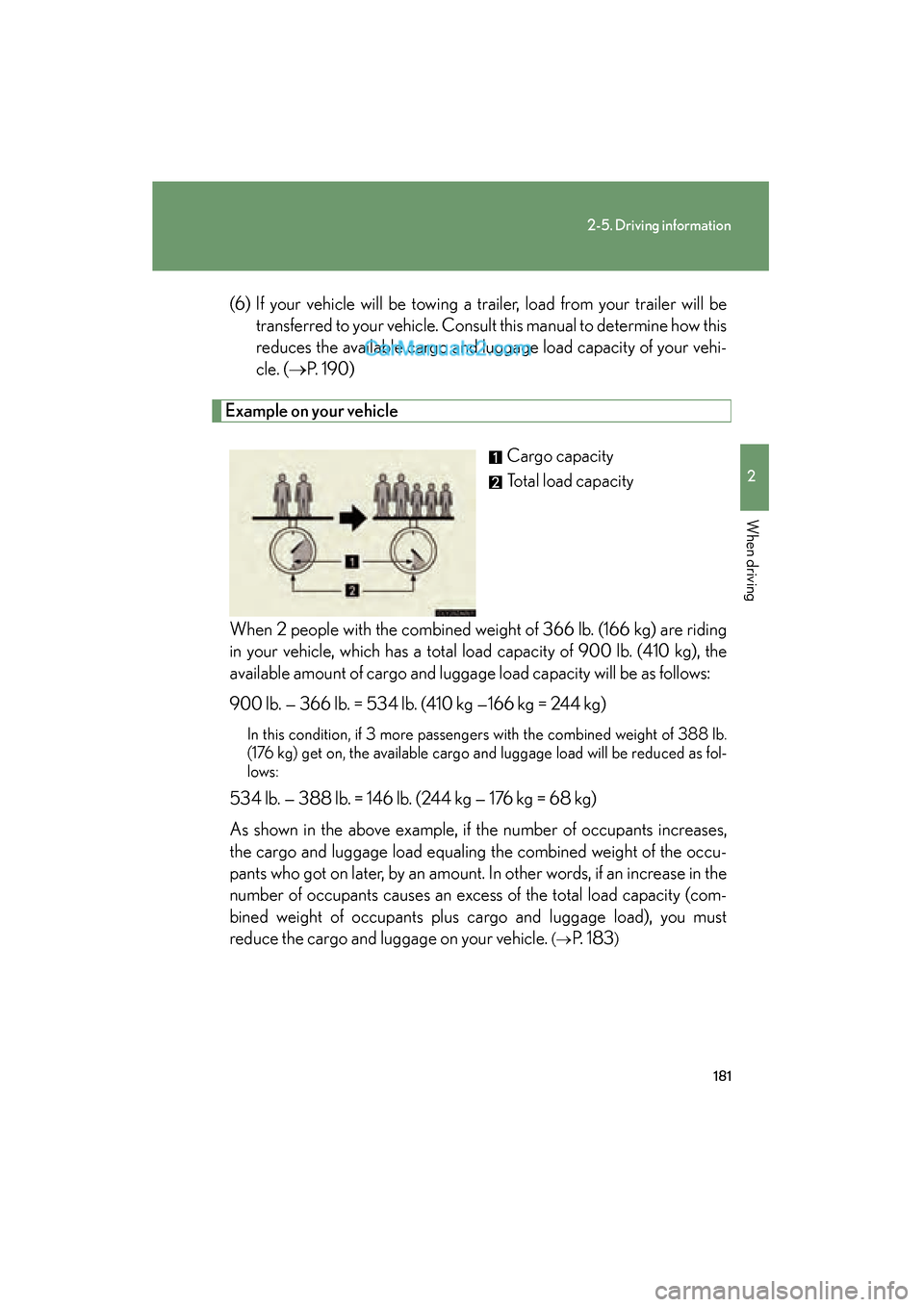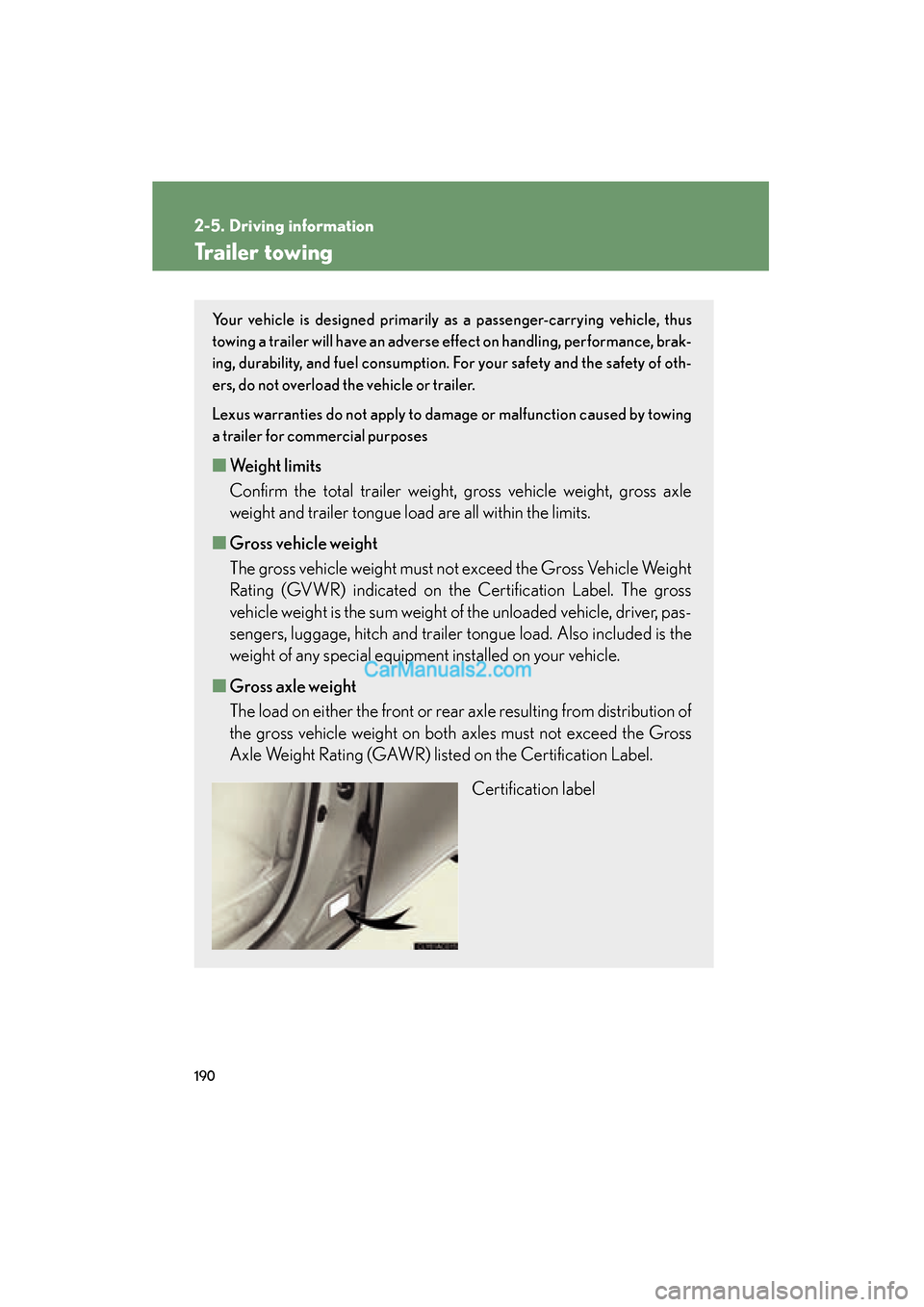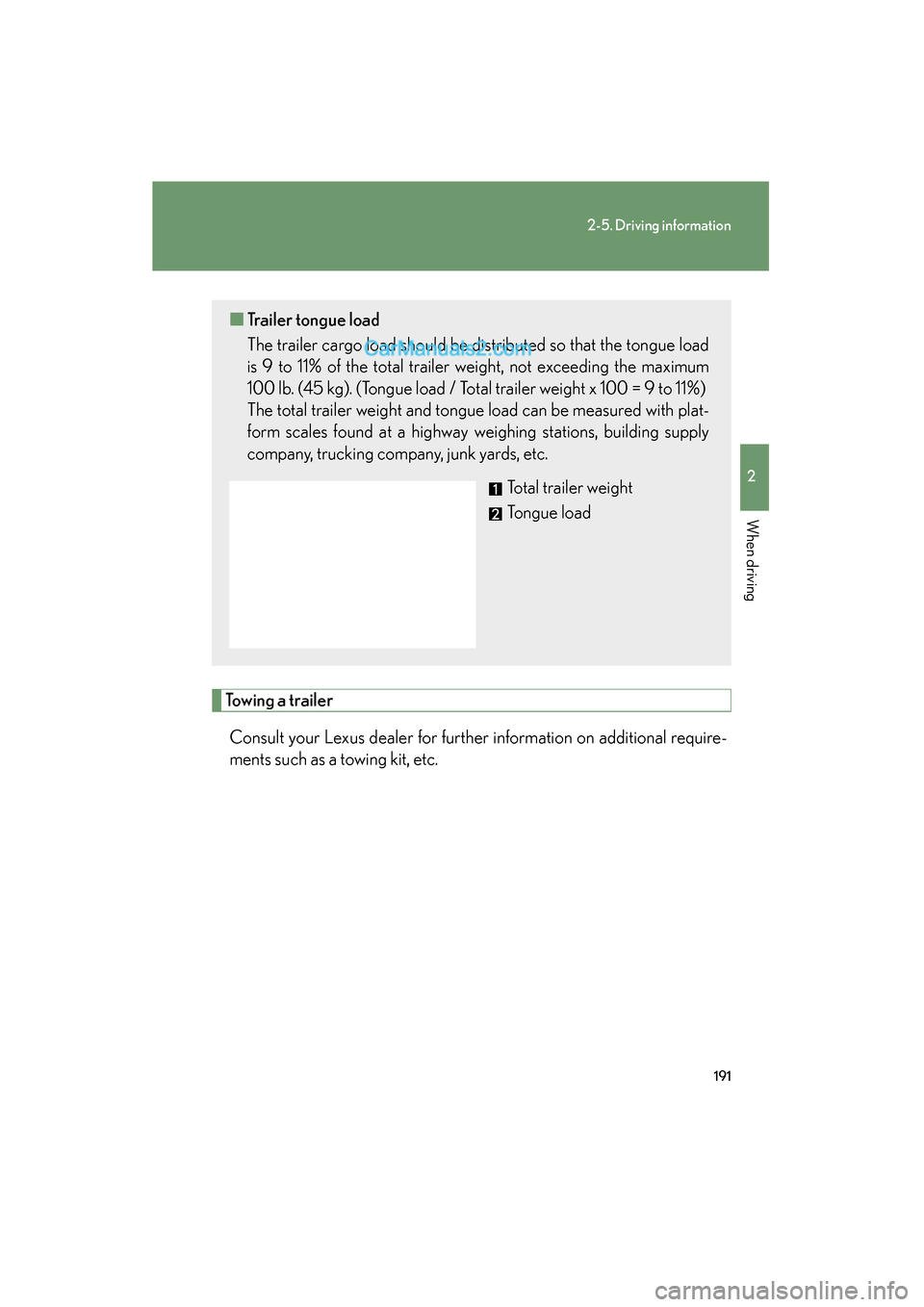2010 Lexus ES350 trailer
[x] Cancel search: trailerPage 5 of 543

1
2
3
4
5
6
7
ES350_U
3
2-2. Instrument clusterGauges and meters ..................... 134
Indicators and warning lights ... 136
Multi-information display........... 140
2-3. Operating the lights and windshield wipers
Headlight switch ............................ 145
Fog light switch .............................. 148
Windshield wipers and washer............................................. 149
2-4. Using other driving systems Cruise control ................................ 152
Dynamic radar cruise control............................................. 155
Intuitive parking assist ................. 165
Driving assist systems.................... 171
PCS (Pre-Collision System)..... 176
2-5. Driving information Cargo and luggage ...................... 180
Vehicle load limits ......................... 183
Winter driving tips ........................ 184
Trailer towing .................................. 190
Dinghy towing ................................ 197 3-1. Using the air conditioning
system and defogger
Automatic air conditioning system ........................................... 200
Rear window and outside rear view mirror
defoggers ..................................... 207
3-2. Using the audio system Audio system type ...................... 208
Using the radio................................. 211
Using the CD player.................... 218
Playing back MP3 and WMA discs.................................. 226
Operating an iPod
®................... 233
Operating a USB memory........ 241
Optimal use of the audio system ........................................... 250
Using the AUX adapter............ 252
Using the steering wheel audio switches ............................ 253
3Interior features
Page 117 of 543

When driving2
115
ES350_U
2-1. Driving proceduresDriving the vehicle................... 116
Engine (ignition) switch ......... 124
Automatic Transmission ........ 128
Turn signal lever ........................ 131
Parking brake ........................... 132
Horn ............................................ 133
2-2. Instrument cluster Gauges and meters ................ 134
Indicators and warning lights ......................................... 136
Multi-information display ..... 140
2-3. Operating the lights and windshield wipers
Headlight switch...................... 145
Fog light switch ........................ 148
Windshield wipers and washer ..................................... 149 2-4. Using other driving
systems
Cruise control.......................... 152
Dynamic radar cruise control ..................................... 155
Intuitive parking assist ........... 165
Driving assist systems .............. 171
PCS (Pre-Collision System) .................................... 176
2-5. Driving information Cargo and luggage ................ 180
Vehicle load limits ................... 183
Winter driving tips .................. 184
Trailer towing ........................... 190
Dinghy towing........................... 197
Page 156 of 543

154
2-4. Using other driving systems
ES350_U
■If the cruise control indicator light flashes
Turn the ON-OFF button off once, and then reactivate the system.
If the cruise control speed cannot be set or if the cruise control cancels immediately
after being activated, there may be a malfunction in the cruise control system. Have
the vehicle inspected by your Lexus dealer.
CAUTION
■To avoid inadvertent cruise control activation
Keep the ON-OFF button off when not in use.
■Situations unsuitable for cruise control
Do not use cruise control in any of the following situations.
Doing so may result in control of the vehicle being lost and could cause an accident
resulting in death or serious injury.
●In heavy traffic
●On roads with sharp bends
●On slippery roads, such as those covered with rain, ice or snow
●On steep hills
●On winding roads
●When towing a trailer or emergency towing
Page 165 of 543

163
2-4. Using other driving systems
2
When driving
ES350_U
CAUTION
■Before using dynamic radar cruise control
Do not overly rely on vehicle-to-vehicle distance control.
Be aware of the set vehicle speed. If automatic deceleration/acceleration is not
appropriate, adjust the vehicle speed, as well as the distance between your vehicle
and vehicles ahead by applying the brakes, etc.
■To avoid inadvertent cruise control activation
Keep the “ON-OFF” button off when not in use.
■Situations unsuitable for dynamic radar cruise control
Do not use dynamic radar cruise control in any of the following situations.
Doing so may result in control of the vehicle being lost and could cause an accident
resulting in death or serious injury.
●In heavy traffic
●On roads with sharp bends
●On winding roads
●On slippery roads, such as those covered with rain, ice or snow.
●On steep downhills, or where there are sudden changes between sharp up and
down gradients
●At entrances to expressways
●When weather conditions are bad enough that they may prevent the sensors
from functioning correctly (fog, snow, sandstorm, etc.)
●Where buzzer can be heard often
●When towing a trailer or emergency towing
■When the radar sensor may not be correctly detecting the vehicle ahead
Apply the brakes as necessary when any of the following types of vehicles are in
front of you.
As the sensor may not be able to correctly detect these types of vehicles, the prox-
imity alarm ( �oP. 449) will not be activated, and an accident may result.
●Vehicles that cut in suddenly
●Vehicles traveling at low speeds
●Vehicles that are not moving
●Vehicles with small rear ends (trailers with no load on board etc.)
Page 183 of 543

181
2-5. Driving information
2
When driving
ES350_U(6) If your vehicle will be towing a trailer, load from your trailer will be
transferred to your vehicle. Consult this manual to determine how this
reduces the available cargo and luggage load capacity of your vehi-
cle. (�o P. 1 9 0 )
Example on your vehicle
Cargo capacity
Total load capacity
When 2 people with the combined weight of 366 lb. (166 kg) are riding
in your vehicle, which has a total load capacity of 900 lb. (410 kg), the
available amount of cargo and luggage load capacity will be as follows:
900 lb. — 366 lb. = 534 lb. (410 kg —166 kg = 244 kg)
In this condition, if 3 more passengers with the combined weight of 388 lb.
(176 kg) get on, the available cargo and luggage load will be reduced as fol-
lows:
534 lb. — 388 lb. = 146 lb. (244 kg — 176 kg = 68 kg)
As shown in the above example, if the number of occupants increases,
the cargo and luggage load equaling the combined weight of the occu-
pants who got on later, by an amount. In other words, if an increase in the
number of occupants causes an excess of the total load capacity (com-
bined weight of occupants plus cargo and luggage load), you must
reduce the cargo and luggage on your vehicle.
( �oP. 1 8 3)
Page 192 of 543

190
2-5. Driving information
ES350_U
Trailer towing
Your vehicle is designed primarily as a passenger-carrying vehicle, thus
towing a trailer will have an adverse effect on handling, performance, brak-
ing, durability, and fuel consumption. For your safety and the safety of oth-
ers, do not overload the vehicle or trailer.
Lexus warranties do not apply to damage or malfunction caused by towing
a trailer for commercial purposes
■Weight limits
Confirm the total trailer weight, gross vehicle weight, gross axle
weight and trailer tongue load are all within the limits.
■ Gross vehicle weight
The gross vehicle weight must not exceed the Gross Vehicle Weight
Rating (GVWR) indicated on the Certification Label. The gross
vehicle weight is the sum weight of the unloaded vehicle, driver, pas-
sengers, luggage, hitch and trailer tongue load. Also included is the
weight of any special equipment installed on your vehicle.
■ Gross axle weight
The load on either the front or rear axle resulting from distribution of
the gross vehicle weight on both axles must not exceed the Gross
Axle Weight Rating (GAWR) listed on the Certification Label.
Certification label
Page 193 of 543

191
2-5. Driving information
2
When driving
ES350_U
Towing a trailerConsult your Lexus dealer for further information on additional require-
ments such as a towing kit, etc.
■ Trailer tongue load
The trailer cargo load should be distributed so that the tongue load
is 9 to 11% of the total trailer weight, not exceeding the maximum
100 lb. (45 kg). (Tongue load / Tota l trailer weight x 100 = 9 to 11%)
The total trailer weight and tongue load can be measured with plat-
form scales found at a highway weighing stations, building supply
company, trucking company, junk yards, etc.
Total trailer weight
Tongue load
Page 194 of 543

192
2-5. Driving information
ES350_U
■Before towing
●Ensure that your vehicle’s tires are properly inflated. (�oP. 396)
●Trailer tires should be inflated according to the trailer manufacturer's recom-
mendation.
●All trailer lights work to be legal.
●Confirm all lights work each time you connect them.
●Check that your vehicle remains level when a loaded or unloaded trailer is
hitched. Do not drive if the vehicle is not level, and check for improper tongue
load, overloading, worn suspension, or other possible causes.
●Make sure the trailer cargo is securely loaded.
●Check that your rear view mirrors conform to any federal, state/provincial or
local regulations. If they do not, install rear view mirrors appropriate for towing
purposes.
■Break-in schedule
Lexus recommends that you do not use a new vehicle or a vehicle with any new
power train components (engine, transmission, differential, wheel bearings, etc.) to
tow a trailer for the first 500 miles (800 km) of driving.
■Maintenance
●If you tow a trailer, your vehicle will require more frequent maintenance due to
the additional load. (See “Warranty and Services Guide/Owner's Manual Sup-
plement/ Scheduled Maintenance”.)
●Retighten the fixing bolts of the towing ball and bracket after approximately
600 miles (1000 km) of trailer towing.
CAUTION
■To avoid accident or injury
●The total trailer weight (trailer weight plus the weight of cargo) must not exceed
1000 lb. (450 kg).
●Do not exceed the trailer hitch assembly weight, gross vehicle weight, gross axle
weight and trailer tongue load capacities.
●Never load more weight in the back than in the front of the trailer. About 60% of
the load should be in the front half of the trailer, and the remaining 40% in the
r e a r.